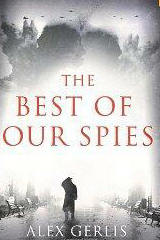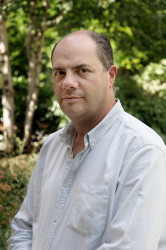Espionage,adventure,drama and love by local author Alex Gerlis
|
“A cracking read which reminded me of John Buchan’s The Thirty-Nine Steps. The characters were lively and the pace brilliantly maintained.”
John Sergeant, broadcaster and author

Just before eleven o’clock in the morning of the first Sunday in May 1941, a French woman in her mid-twenties emerged from Ealing Common station. She was wearing a woollen scarf around her head and a raincoat described as being “closer to shabby than smart”.
She turned right and, staying on the southern side of Uxbridge Road walked about four hundred yards in the direction of Acton. Her destination was the narrow strip of park known as Twyford Gardens, which runs parallel to the northern side of Uxbridge Road. Once she could tell that it was safe, she crossed the road and entered the small park.
Those two paragraphs summarise a substantial chunk of Chapter Four of my first novel, The Best of Our Spies. What I describe there did not actually happen, but like most of the book, it is a careful mixture of fact and fiction. This balance of fact and fiction is a tricky one, especially when dealing with a topic such as the Second World War. Not only is it a sensitive one, still fresh in many people’s memory, but it is also a subject that many people know an awful lot about. The need to be accurate is paramount. Of course, it would be wrong to pretend that The Best of Our Spies is anything other than a work of fiction, but I did go to some considerable extent to ensure that where the novel was obviously dealing with matters of fact, then it was as authentic as possible. I visited most of the locations in the book; I carried out some primary research in both Britain and France and kept a large pile of history books by the side of my desk to consult whenever necessary. I used the standard journalistic technique of ensuring that I had at least two sources on all the facts that I used in the book.
The trick then is to ensure that this research does not sit too heavily, that it does not read like a history book as opposed to a novel. It is not easy to achieve that: on the one hand you want the ‘joins’ between fact and fiction to be apparent, so that the reader does not feel that they are being misled. On the other hand, you want the book to be seamless, so that the pace of the story, the plot and the characters carry the reader along.
I hope that I have achieved that, though that is something for the reader to judge. The fiction elements in The Best of Our Spies are never very far from the truth. The truth in the case of the French woman visiting Twyford Gardens is that this small park does indeed play a little-known but nonetheless significant part in British espionage history. It is there where the Soviet spy Donald Maclean – then a Foreign Office diplomat – would travel to meet his Russian minder. Both men would take long and circuitous routes to get to Ealing Common station in an effort to avoid anyone from MI5 who may have been following them.
I first came up with the plot for The Best of Our Spies back in 1994 when I was one of the producers on the BBC’s coverage of the 50th anniversary of D-Day. As part of my research I read a lot about D-Day and realised just how close it had come to failure. Had it not been for an extraordinarily effective operation by the Allies to trick the Germans into thinking D-Day would take place elsewhere in France then the outcome of the war could have been very different.
That deception plan, known as Operation Fortitude, is at the heart of the novel. The Best of Our Spies is set in England and France and is the story of Owen Quinn, a young Royal Navy officer. Owen is injured when his ship is sunk in the Med and he ends up working in Intelligence, helping to plan D-Day. While recovering from his injuries he meets Nathalie, a young French nurse who fled to England when France fell. The tale that unfolds is one of espionage, adventure, drama and love.
Although the first seeds of The Best of Our Spies were sown back in 1994, I only began to write it in 2008. On the basis of the first version I was fortunate enough to be taken on Curtis Brown, who are leading London literary agents. The book went through a couple more re-writes, growing by around forty thousand words in the process (it is now just under 170,000 words).
The novel has been published through CB Creative Books, which is part of Curtis Brown. It came out in December and the Kindle sales in particular have been very strong. At one stage in January it was even ranked at number two in Amazon’s Kindle Spy Stories category, above the likes of John le Carré and Ken Follett.
The Best of Our Spies is available at The Pitshanger Bookshop (141 Pitshanger Lane, W5) or through Amazon: here
20th February 2013
